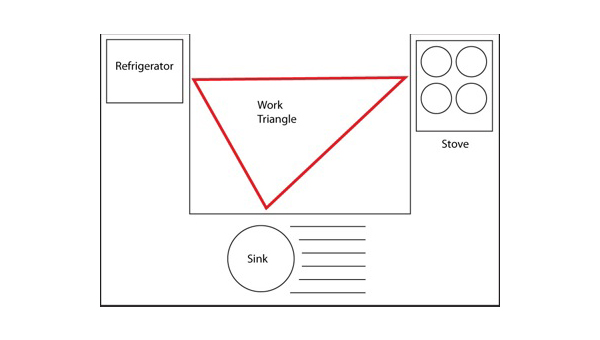
The kitchen work triangle is a concept used to determine efficient kitchen layouts that are both aesthetic and functional. The primary tasks in a home kitchen are carried out between the cook top, the sink and the refrigerator. These three points and the imaginary lines between them, make up what kitchen experts call the work triangle. The idea is that when these three elements are in close (but not too close) proximity to one other, the kitchen will be easy and efficient to use, cutting down on wasted steps.
There are exceptions to this rule: in single wall kitchens, it’s geometrically impossible to achieve a true triangle—but efficiency can still be achieved through the configuration of the three items, and how far apart they are.
There are exceptions to this rule: in single wall kitchens, it’s geometrically impossible to achieve a true triangle—but efficiency can still be achieved through the configuration of the three items, and how far apart they are.
Application
The kitchen work triangle principle is used by kitchen designers and architects when designing residential kitchens:
Besides the work triangle itself, there are several rules of thumb to consider when planning a kitchen:
- No leg of the triangle should be less than 4 feet (1.2 m) or more than 9 feet (2.7 m).
- The sum of all three sides of the triangle should be between 13 feet (4.0 m) and 26 feet (7.9 m).
- Cabinets or other obstacles should not intersect any leg of the triangle by more than 12 inches (30 cm).
- If possible, there should be no major traffic flow through the triangle.
- A full-height obstacle, such as a tall cabinet, should not come between any two points of the triangle.
Besides the work triangle itself, there are several rules of thumb to consider when planning a kitchen:
- As measured between countertops and cabinets or appliances, work aisles should be no less than 42 inches (110 cm) for one cook, or 48 inches (120 cm) for multiple cooks.
- A sink should have a clear counter area of at least 24 inches (61 cm) on one side, and at least 18 inches (46 cm) on the other side.
- A refrigerator should have a clear counter area of at least 15 inches (38 cm) on the handle side; or the same on either side of a side-by-side refrigerator; or the same area on a counter no more than 48 inches (120 cm) across from the refrigerator.
- A stove or cooktop should have a clear 15 inches (38 cm) area on one side, and at least 12 inches (30 cm) on the other side.
- At least 36 inches (91 cm) of food preparation area should be located next to the sink.
- In a seating area where no traffic passes behind the diner, allow 32 inches (81 cm) from the wall to the edge of the table or counter; if traffic passes behind the diner, allow 44 inches (110 cm).

